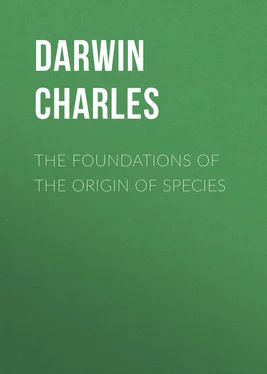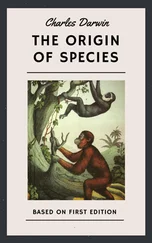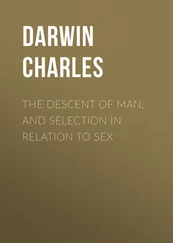Charles Darwin - The Foundations of the Origin of Species
Здесь есть возможность читать онлайн «Charles Darwin - The Foundations of the Origin of Species» — ознакомительный отрывок электронной книги совершенно бесплатно, а после прочтения отрывка купить полную версию. В некоторых случаях можно слушать аудио, скачать через торрент в формате fb2 и присутствует краткое содержание. Жанр: foreign_antique, foreign_prose, на английском языке. Описание произведения, (предисловие) а так же отзывы посетителей доступны на портале библиотеки ЛибКат.
- Название:The Foundations of the Origin of Species
- Автор:
- Жанр:
- Год:неизвестен
- ISBN:нет данных
- Рейтинг книги:3 / 5. Голосов: 1
-
Избранное:Добавить в избранное
- Отзывы:
-
Ваша оценка:
- 60
- 1
- 2
- 3
- 4
- 5
The Foundations of the Origin of Species: краткое содержание, описание и аннотация
Предлагаем к чтению аннотацию, описание, краткое содержание или предисловие (зависит от того, что написал сам автор книги «The Foundations of the Origin of Species»). Если вы не нашли необходимую информацию о книге — напишите в комментариях, мы постараемся отыскать её.
The Foundations of the Origin of Species — читать онлайн ознакомительный отрывок
Ниже представлен текст книги, разбитый по страницам. Система сохранения места последней прочитанной страницы, позволяет с удобством читать онлайн бесплатно книгу «The Foundations of the Origin of Species», без необходимости каждый раз заново искать на чём Вы остановились. Поставьте закладку, и сможете в любой момент перейти на страницу, на которой закончили чтение.
Интервал:
Закладка:
Thus there is no power to change the course of the arteries, as long as they nourish the fœtus; it is the selection of slight changes which supervene at any time during «illegible» of life.
The less differences of fœtus, – this has obvious meaning on this view: otherwise how strange that a [monkey] horse, a man, a bat should at one time of life have arteries, running in a manner, which is only intelligibly useful in a fish! The natural system being on theory genealogical, we can at once see, why fœtus, retaining traces of the ancestral form, is of the highest value in classification.
§ IX. «Abortive organs.»
There is another grand class of facts relating to what are called abortive organs. These consist of organs which the same reasoning power that shows us how beautifully these organs in some cases are adapted to certain end, declares in other cases are absolutely useless. Thus teeth in Rhinoceros 165, whale, narwhal, – bone on tibia, muscles which do not move, – little bone of wing of Apteryx, – bone representing extremities in some snake, – little wings within «?» soldered cover of beetles, – men and bulls, mammæ: filaments without anthers in plants, mere scales representing petals in others, in feather-hyacinth whole flower. Almost infinitely numerous. No one can reflect on these without astonishment, can anything be clearer than that wings are to fly and teeth «to bite», and yet we find these organs perfect in every detail in situations where they cannot possibly be of their normal use 166.
The term abortive organ has been thus applied to above structure (as invariable as all other parts 167) from their absolute similarity to monstrous cases, where from accident , certain organs are not developed; as infant without arms or fingers with mere stump representing them: teeth represented by mere points of ossification: headless children with mere button, – viscera represented by small amorphous masses, &c., – the tail by mere stump, – a solid horn by minute hanging one 168. There is a tendency in all these cases, when life is preserved, for such structures to become hereditary. We see it in tailless dogs and cats. In plants we see this strikingly, – in Thyme, in Linum flavum , – stamen in Geranium pyrenaicum 169. Nectaries abort into petals in Columbine « Aquilegia », produced from some accident and then become hereditary, in some cases only when propagated by buds, in other cases by seed. These cases have been produced suddenly by accident in early growth, but it is part of law of growth that when any organ is not used it tends to diminish (duck’s wing 170?) muscles of dog’s ears, «and of» rabbits, muscles wither, arteries grow up. When eye born defective, optic nerve (Tuco Tuco) is atrophied. As every part whether useful or not (diseases, double flowers) tends to be transmitted to offspring, the origin of abortive organs whether produced at the birth or slowly acquired is easily understood in domestic races of organisms: [a struggle between the atrophy and hereditariness. Abortive organs in domestic races.] There will always be a struggle between atrophy of an organ rendered useless, and hereditariness 171. Because we can understand the origin of abortive organs in certain cases, it would be wrong to conclude absolutely that all must have had same origin, but the strongest analogy is in favour of it. And we can by our theory, for during infinite changes some organ, we might have anticipated, would have become useless. «We can» readily explain the fact, so astounding on any other view, namely that organs possibly useless have been formed often with the same exquisite care as when of vital importance.
Our theory, I may remark would permit an organ «to» become abortive with respect to its primary use, to be turned to any other purpose, (as the buds in a cauliflower) thus we can see no difficulty in bones of male marsupials being used as fulcrum of muscles, or style of marygold 172, – indeed in one point of view, the heads of [vertebrated] animal may be said to be abortive vertebræ turned into other use: legs of some crustacea abortive jaws, &c., &c. De Candolle's analogy of table covered with dishes 173.
«The following passage was possibly intended to be inserted here.» Degradation and complication see Lamarck: no tendency to perfection: if room, [even] high organism would have greater power in beating lower one, thought «?» to be selected for a degraded end.
§ X. Recapitulation and conclusion
Let us recapitulate the whole «?» «of» these latter sections by taking case of the three species of Rhinoceros, which inhabit Java, Sumatra, and mainland of Malacca or India. We find these three close neighbours, occupants of distinct but neighbouring districts, as a group having a different aspect from the Rhinoceros of Africa, though some of these latter inhabit very similar countries, but others most diverse stations. We find them intimately related [scarcely «?» differences more than some breeds of cattle] in structure to the Rhinoceros, which for immense periods have inhabited this one, out of three main zoological divisions of the world. Yet some of these ancient animals were fitted to very different stations: we find all three «illegible» of the generic character of the Rhinoceros, which form a [piece of net] 174set of links in the broken chain representing the Pachydermata, as the chain likewise forms a portion in other and longer chains. We see this wonderfully in dissecting the coarse leg of all three and finding nearly the same bones as in bat’s wings or man’s hand, but we see the clear mark in solid tibia of the fusion into it of the fibula. In all three we find their heads composed of three altered vertebræ, short neck, same bones as giraffe. In the upper jaws of all three we find small teeth like rabbit’s. In dissecting them in fœtal state we find at a not very early stage their form exactly alike the most different animals, and even with arteries running as in a fish: and this similarity holds when the young one is produced in womb, pond, egg or spawn. Now these three undoubted species scarcely differ more than breeds of cattle, are probably subject to many the same contagious diseases; if domesticated these forms would vary, and they might possibly breed together, and fuse into something 175different «from» their aboriginal forms; might be selected to serve different ends.
Now the Creationist believes these three Rhinoceroses were created 176with their deceptive appearance of true, not «illegible» relationship; as well can I believe the planets revolve in their present courses not from one law of gravity but from distinct volition of Creator.
If real species, sterile one with another, differently adapted, now inhabiting different countries, with different structures and instincts, are admitted to have common descent, we can only legitimately stop where our facts stop. Look how far in some case a chain of species will lead us. «This probably refers to the Crustacea, where the two ends of the series have “hardly a character in common.” Origin , Ed. i. p. 419.» May we not jump (considering how much extermination, and how imperfect geological records) from one sub-genus to another sub-genus. Can genera restrain us; many of the same arguments, which made us give up species, inexorably demand genera and families and orders to fall, and classes tottering. We ought to stop only when clear unity of type, independent of use and adaptation, ceases.
Be it remembered no naturalist pretends to give test from external characters of species; in many genera the distinction is quite arbitrary 177. But there remains one other way of comparing species with races; it is to compare the effects of crossing them. Would it not be wonderful, if the union of two organisms, produced by two separate acts of Creation, blended their characters together when crossed according to the same rules, as two races which have undoubtedly descended from same parent stock; yet this can be shown to be the case. For sterility, though a usual «?», is not an invariable concomitant, it varies much in degree and has been shown to be probably dependent on causes closely analogous with those which make domesticated organisms sterile. Independent of sterility there is no difference between mongrels and hybrids, as can be shown in a long series of facts. It is strikingly seen in cases of instincts, when the minds of the two species or races become blended together 178. In both cases if the half-breed be crossed with either parent for a few generations, all traces of the one parent form is lost (as Kölreuter in two tobacco species almost sterile together), so that the Creationist in the case of a species, must believe that one act of creation is absorbed into another!
Читать дальшеИнтервал:
Закладка:
Похожие книги на «The Foundations of the Origin of Species»
Представляем Вашему вниманию похожие книги на «The Foundations of the Origin of Species» списком для выбора. Мы отобрали схожую по названию и смыслу литературу в надежде предоставить читателям больше вариантов отыскать новые, интересные, ещё непрочитанные произведения.
Обсуждение, отзывы о книге «The Foundations of the Origin of Species» и просто собственные мнения читателей. Оставьте ваши комментарии, напишите, что Вы думаете о произведении, его смысле или главных героях. Укажите что конкретно понравилось, а что нет, и почему Вы так считаете.












